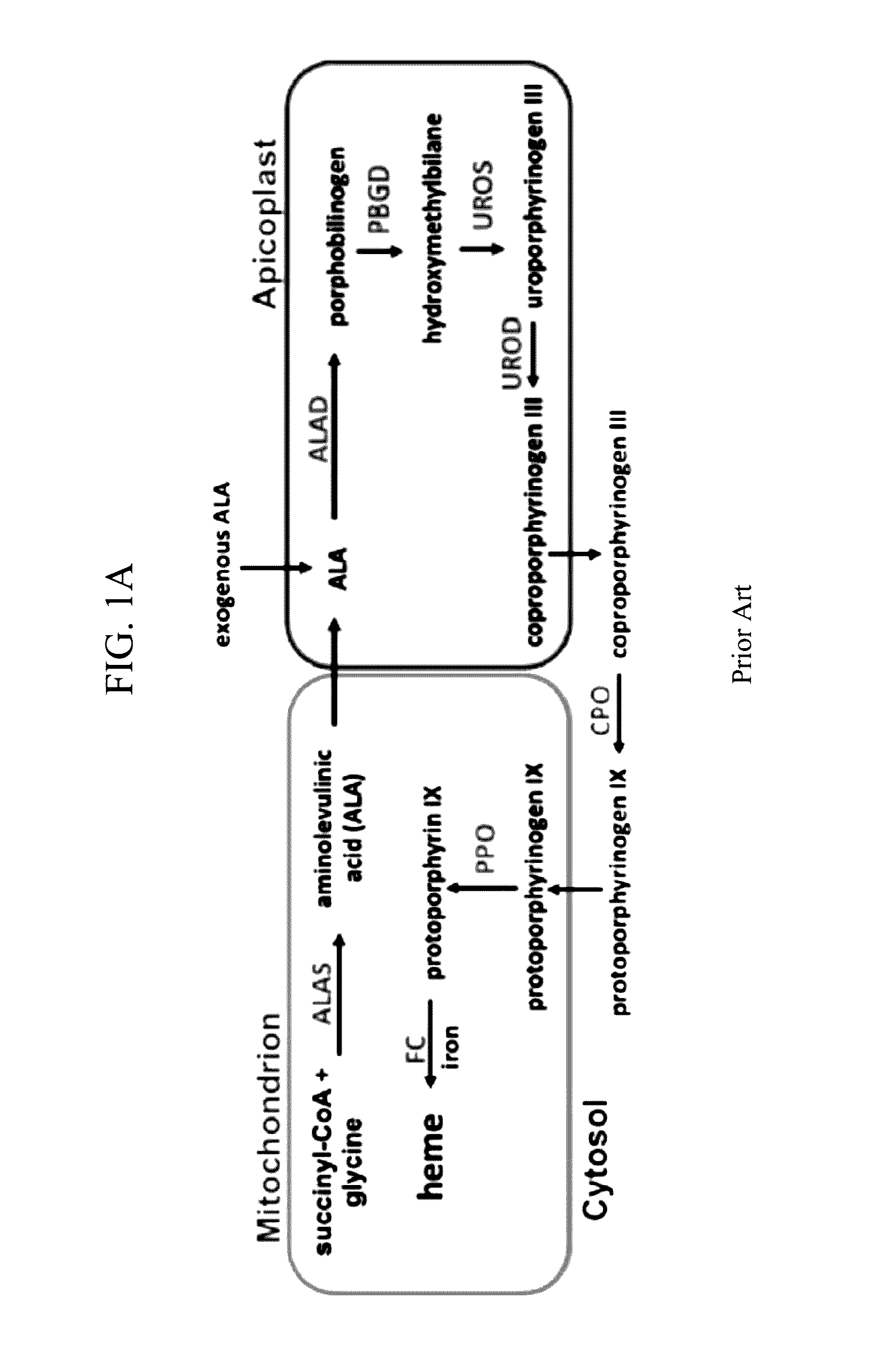Combination artemisinin and chemiluminescent photodynamic therapy and uses therefor
a technology of chemiluminescent and photodynamic therapy, which is applied in the field of combination artemisinin and chemiluminescent photodynamic therapy and uses therefor, can solve the problems of not disclosing the use of art in pdt, resurgence of malaria deaths, and loss of efficacy
- Summary
- Abstract
- Description
- Claims
- Application Information
AI Technical Summary
Benefits of technology
Problems solved by technology
Method used
Image
Examples
example 1
Exogenous ALA can be used to Stimulate Heme Biosynthesis and Photosensitize Parasites
[0069]The present inventors investigated whether ALA treatment could serve as a probe of heme biosynthesis activity in Plasmodium-infected erythrocytes by enabling direct visualization of PPIX production and the cellular consequences of light activation. Untreated parasites imaged on an epifluorescence microscope display only background auto-fluorescence from hemozoin crystals in the parasite digestive vacuole (FIG. 2). Parasites grown in 200 μM ALA, however, display bright red fluorescence distributed throughout the infected erythrocyte, as expected for accumulation of PPIX (additional discussion below).
[0070]The cytotoxic effects of light-activating PPIX were readily apparent by monitoring the motion of hemozoin crystals that dynamically tumble within the digestive vacuole of individual parasites. Although the origin and physiological significance of this motion remain unknown, hemozoin dynamics s...
example 2
Stable Disruption of Parasite Enzymes and the Apicoplast do not affect Heme Biosynthesis from ALA
[0072]Upstream enzymes in the parasite-encoded heme biosynthesis pathway are amenable to genetic disruptions that block production of PPIX from exogenous ALA (FIG. 1A) and thus prevent parasite photosensitivity. The parasite genes encoding the apicoplast-targeted porphobilinogen deaminase (PBGD) and cytosolic coproporphyrinogen III oxidase (CPO) were successfully disrupted using single-crossover homologous recombination to truncate the open reading frame for each gene. Southern blot and PCR analysis confirmed correct integration and gene disruption in clonal parasite lines. These genetic disruptions had no effect on the ability of parasite-infected erythrocytes to incorporate 13C-labelled ALA into heme, PPIX, or coproporphyrinogen III (FIG. 5A), as monitored by a previously developed tandem mass spectrometry assay (Ke, H. et al., J. Biol. Chem. 289, 34827-34837, 2014), and clonal growth ...
example 3
Erythrocytes Retain Vestigial Heme Biosynthesis Enzymes with Latent Activity in ALA
[0074]In these investigations, red porphyrin fluorescence in ALA-treated intraerythrocytic parasites was not limited to the parasitophorous vacuole but was detectable throughout the erythrocyte cytoplasm (FIG. 3A), as expected for host enzyme activity in this compartment and production of PPIX. To directly test the model that enzymes remaining in the erythrocyte cytoplasm could catalyze PPIX biosynthesis from ALA, the present inventors permeabilized uninfected erythrocytes using the plant-derived detergent saponin, clarified lysates by centrifugation (25,000×g for 60 min.) followed by sterile filtration (0.2 μM), and then used tandem mass spectrometry to monitor heme and porphyrin biosynthesis from 13C-labelled ALA added to the filtered lysate supernatant. The inventors detected formation of 13C-labelled PPIX and coproporphyrin III (the spontaneous oxidation product of the pathway intermediate copropo...
PUM
| Property | Measurement | Unit |
|---|---|---|
| chemiluminescent | aaaaa | aaaaa |
| chemiluminescence | aaaaa | aaaaa |
| chemiluminescent luminol | aaaaa | aaaaa |
Abstract
Description
Claims
Application Information
 Login to View More
Login to View More - R&D
- Intellectual Property
- Life Sciences
- Materials
- Tech Scout
- Unparalleled Data Quality
- Higher Quality Content
- 60% Fewer Hallucinations
Browse by: Latest US Patents, China's latest patents, Technical Efficacy Thesaurus, Application Domain, Technology Topic, Popular Technical Reports.
© 2025 PatSnap. All rights reserved.Legal|Privacy policy|Modern Slavery Act Transparency Statement|Sitemap|About US| Contact US: help@patsnap.com



